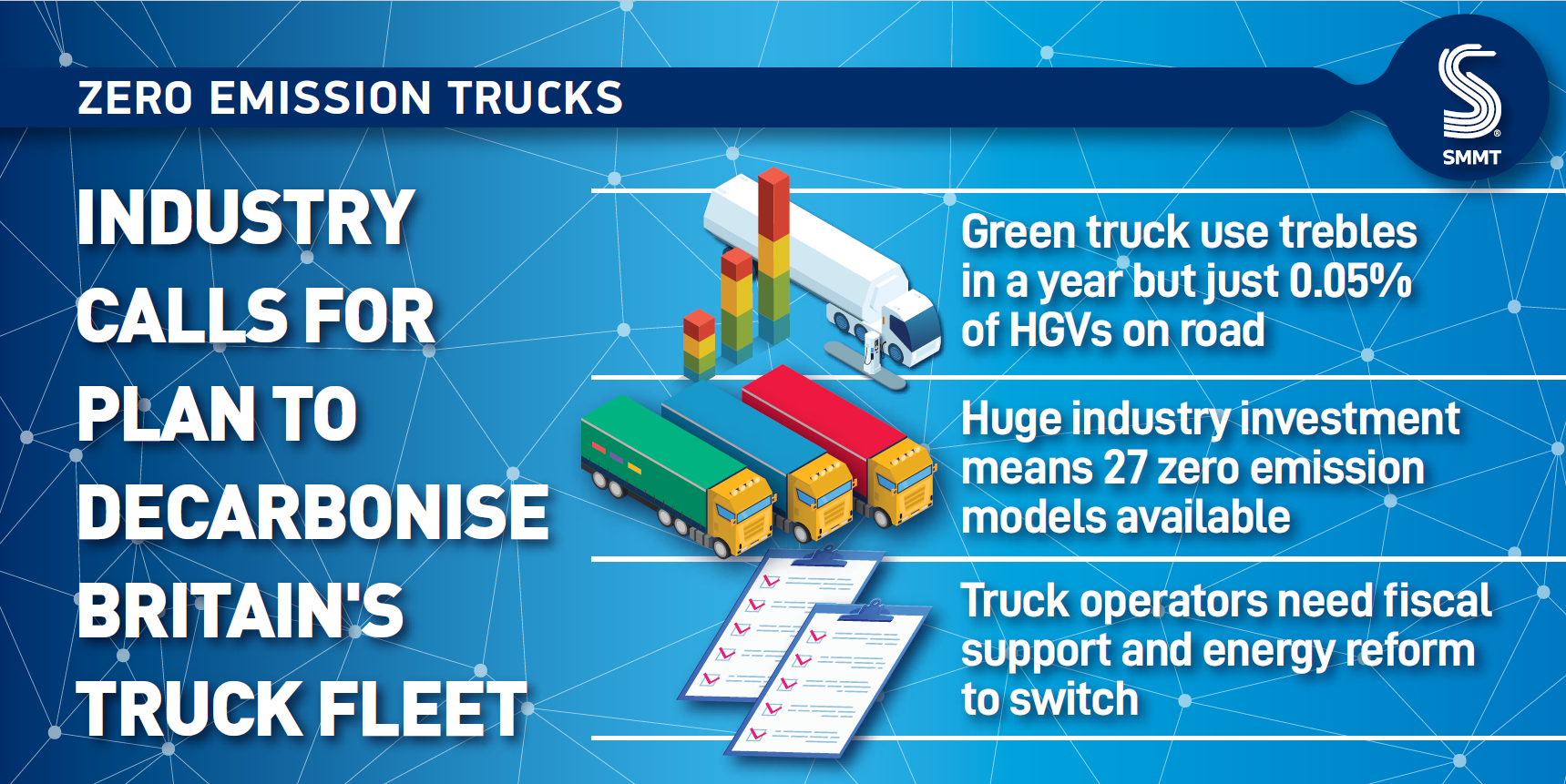Commercial Vehicle Show 2024
Commercial Vehicle Show 2024
Industry calls for ‘next generation’ incentive and infrastructure plan to decarbonise Britain’s truck fleet
- Zero emission HGV use trebles in a year – but accounts for just 0.05% of HGVs on the road with end of sale in 2035.
- Massive manufacturer investment means operators can choose from 27 different zero emission trucks – but slow approval process means just two in five models are currently eligible for government grants.
- At the Commercial Vehicle Show 2024, industry calls for fiscal and energy reform to boost operator confidence to switch – and cut CO2 by almost 19 million tonnes a year.

Tuesday 23 April, 2024
Government should reform its dated Plug-in Truck Grant – introduced eight years ago – to reflect the progress made by the sector in developing new zero emission truck technology and help cut CO2 by 18.8 million tonnes a year, says the Society of Motor Manufacturers and Traders (SMMT).1
Following billions in investment from manufacturers, there are now 27 models of zero emission trucks available to UK operators with many more to come.2 While the Plug-in Truck Grant, introduced in 2016, seeks to help operators switch from conventionally fuelled heavy commercial vehicles to zero emission alternatives, models can only be eligible after undertaking an approval process that takes around two years. As a result, less than half (10) ZEV truck models on the market today are currently eligible for grants.3
Given new truck purchases are critical long-term investments for hauliers operating with tight margins, transitioning to zero emission operations requires commercial benefit and operator confidence. Zero emission trucks are currently more expensive to manufacture so grants are essential if operators are to benefit from the many advantages, including potentially lower running costs, quieter operations and more positive public perception.
While 2024 saw a record number of new zero emission trucks registered, there are still just 327 vehicles in operation – meaning drivers are more likely to encounter a pink van (564 on the road) than a plug-in truck.4 These trucks already meet a wide range of business needs – with vehicles up to 44 tonnes and ranges of up to 311 miles – but fleets need a ‘next generation’ incentive scheme which makes it much easier for new zero emission trucks to qualify, plus a dedicated national infrastructure plan to power Britain’s road haulage fleet.
Hauliers who have already committed to fleet carbon reduction must then install depot charging or refuelling – a significant additional, but essential, cost – to ensure they can use their zero emission vehicles as easily and flexibly as their business requires. However, HGV operators do not have the same access to infrastructure installation support as other sectors, and even those who have the resources to invest in depot chargepoints face additional hurdles in terms of grid connectivity and local planning constraints. The challenge continues once out on the road as there is currently just one HGV-dedicated public charge location in the whole country, on the M61 Southbound at Rivington – preventing longer distance operators from going green.
Given truck decarbonisation is essential to the UK’s 2035 net zero targets and with the end of sale of new non-zero emission HGVs weighing less than 26 tonnes coming at the same time as the car and van sectors, urgent action is needed to create the right conditions to allow hauliers to plan their net zero investments.
Operators need to see a nationally consistent, locally delivered plan for charging infrastructure, the provision of genuinely compelling incentives for vehicle purchases, as well as support for depot investment. A national plan must also reform planning laws to speed up grid connectivity at depot sites, while ramping up the provision of HGV-dedicated public charging infrastructure to make the transition fair and accessible for all operators.
Mike Hawes, SMMT Chief Executive, said,
2023 was the best year ever for zero emission truck uptake but they remain a tiny fraction of the UK’s fleet. With an end of sale date of some fossil fuel HGVs starting in less than 11 years’ time – the same as cars and vans – urgent action is required. Operators facing higher capital expenditure, a paucity of dedicated charging infrastructure, planning constraints and grid delays to depot upgrades, need a next generation incentive and infrastructure strategy and planning reform if they are to invest in the greener future the country needs. Doing so would not just cut carbon and improve air quality, it would put the UK at the forefront of global road transport decarbonisation.
The Commercial Vehicle Show 2024 opens today at the NEC Birmingham and runs to Thursday 25 April, with manufacturers exhibiting the very latest truck and van technology, from electric and hydrogen vehicles to cutting-edge components and services. The event, which is free to attend, will also stage an all-new seminar series, The Road Ahead, discussing the industry’s core issues such as HGV fleet decarbonisation, depot charging infrastructure, workforce wellbeing, and skills and recruitment.
Notes to Editors
1. Based on replacing all vehicles in the UK HGV fleet with zero emission vehicles – CO2 emissions from 2022 UK HGV fleet – National Statistics
2. Based on SMMT registration data
3. Based on models with complete eligibility – Low-emission vehicles eligible for a plug-in grant
4. SMMT motorparc data, 2023 – based on vehicles weighing >4.25 tonnes
File Downloads
- CV Show 2024
CV Show 2024
| Title | Description | Version | Size | Download |
|---|---|---|---|---|
| Zero Emission Trucks | 0.98 MB | DownloadPreview | ||
| SMMT News Release – Zero Emission HGV Paper 2024 | 105.77 KB | Download |

Comments are closed.